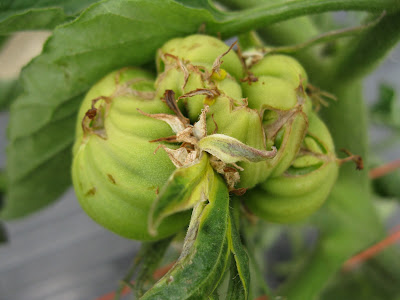I chose Cherokee Purple as the scion variety in my grafting trials because it is a popular heirloom that is stingy on yield. Heirloom varieties are given to more sporadic behavior. They don't perform as consistently as the meticulously selected commercial hybrids. The standard varieties, often hybrids, are the athletes of the tomato world. They grow and flower and fruit consistently and well. The heirloom varieties are beautiful in color, mostly great in flavor, but given to some odd habits. Growth habits, specifically.
The apical meristem of the Cherokee Purple often develops an inflorescence. At the apex of this inflorescence, the stem leading to the flower (the peduncle in botany-speak) and the resulting 2-4 flowers are fused together.
This variety is also planted in a second project at the research station that is collaborating with two universities in Texas and Tennessee. We asked them whether we should remove the fruit or not, as it will likely result in unmarketable fruit. They have not been removing them, since they believe that growers wouldn't remove them in the same situation. Therefore, we have not been pruning them off.
This is a Cherokee Purple fruit developing 2 weeks after the flower photos above. This is some serious cat-facing that might result in increased susceptibility to pathogens (read: rotten and diseased fruit). Pruning off this fused flower at the apex of the main leader might be worth considering, if we choose to grow the same variety next year.


